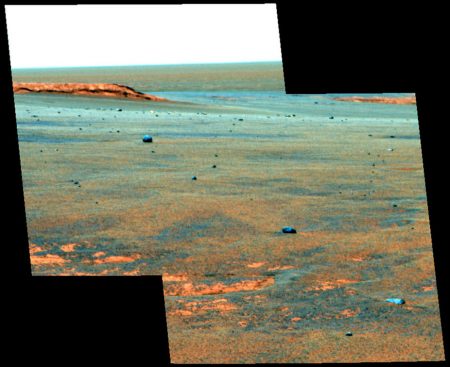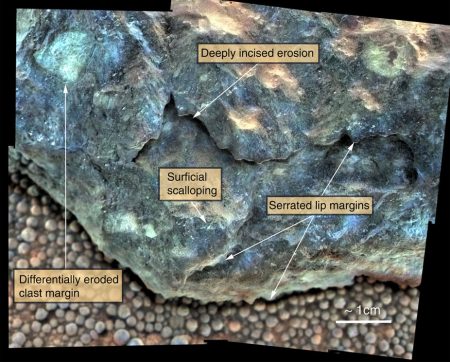November 12, 2016 – In a study appearing in Nature Communications, entitled Amazonian chemical weathering rate derived from stony meteorite finds at Meridiani Planum on Mars, scientists conclude that the Mars of today is drier than any place on Earth and has been that way for millions of years.
If Martian life survived from its wet past dating back 3 billion years, it is nowhere to be found on or near the surface today. The Meridiani Planum meteorites were first examined by Opportunity, the surviving Martian rover that was part of a twin set that arrived on Mars over 12 years ago. Opportunity in its journey to Victoria Crater found meteorite fragments seen below in the false colour image. The meteorites stand out from surrounding landscape and provide a good reference point for studying chemical weathering on the planet’s surface.

The weathering of the ferric iron content as analyzed by Opportunity’s on board spectrometer, has been compared to similar meteorites collected from Earth environments. On Earth chemical weathering rates in Antarctica are slower than anywhere else on Earth. But on Mars evidence shows that weathering is 4 orders of magnitude slower than Antarctica. In fact the weathering of Martian meteorites shows no evidence for liquid water within the chemical process.
The existence of water has been found by Curiosity, the other operating rover studying conditions in Gale Crater. It observes seasonal changes to relative humidity close to the Martian surface with the formation of salty brines containing perchlorates within the top 5 centimeters (2 inches) of the planet’s soil. But the moisture levels observed are far less than that found on Earth’s driest places.
The Spirit rover had made similar observations when studying Gusev Crater. In fact the rover’s demise was caused probably by its wheels breaking through a soil crust in a small crater. Operators of Spirit surmise that the crust formed from evaporated salty brine that hid the sand beneath.
Getting back to the Meridiani meteorites and what they tell us about current Martian surface conditions, indicates that Mars appears to be in an interglacial period experiencing very dry conditions in equatorial regions of the planet. The extreme aridity is 4 orders of magnitude greater than the driest place on Earth. It is highly unlikely, therefore, that Martian life can exist in these areas where current Martian explorations have taken us.

Dr Christian Schröder, Lecturer in Environmental Science and Planetary Exploration at University of Stirling, a principal member of the research team that produced the above-mentioned paper, states, “Evidence shows that more than 3 billion years ago Mars was wet and habitable. However, this latest research reaffirms just how dry the environment is today. For life to exist in the areas we investigated, it would need to find pockets far beneath the surface, located away from the dryness and radiation present on the ground.”







